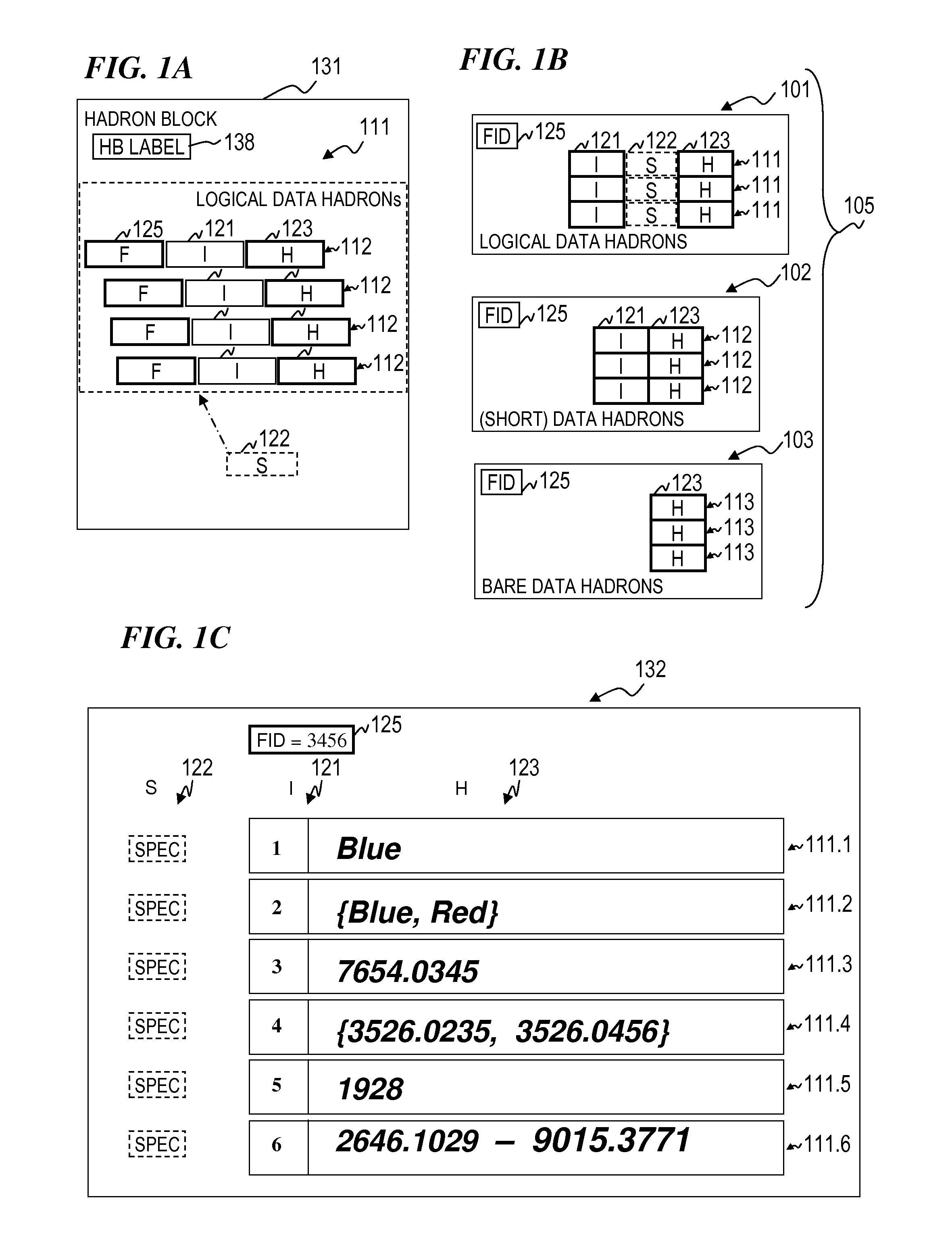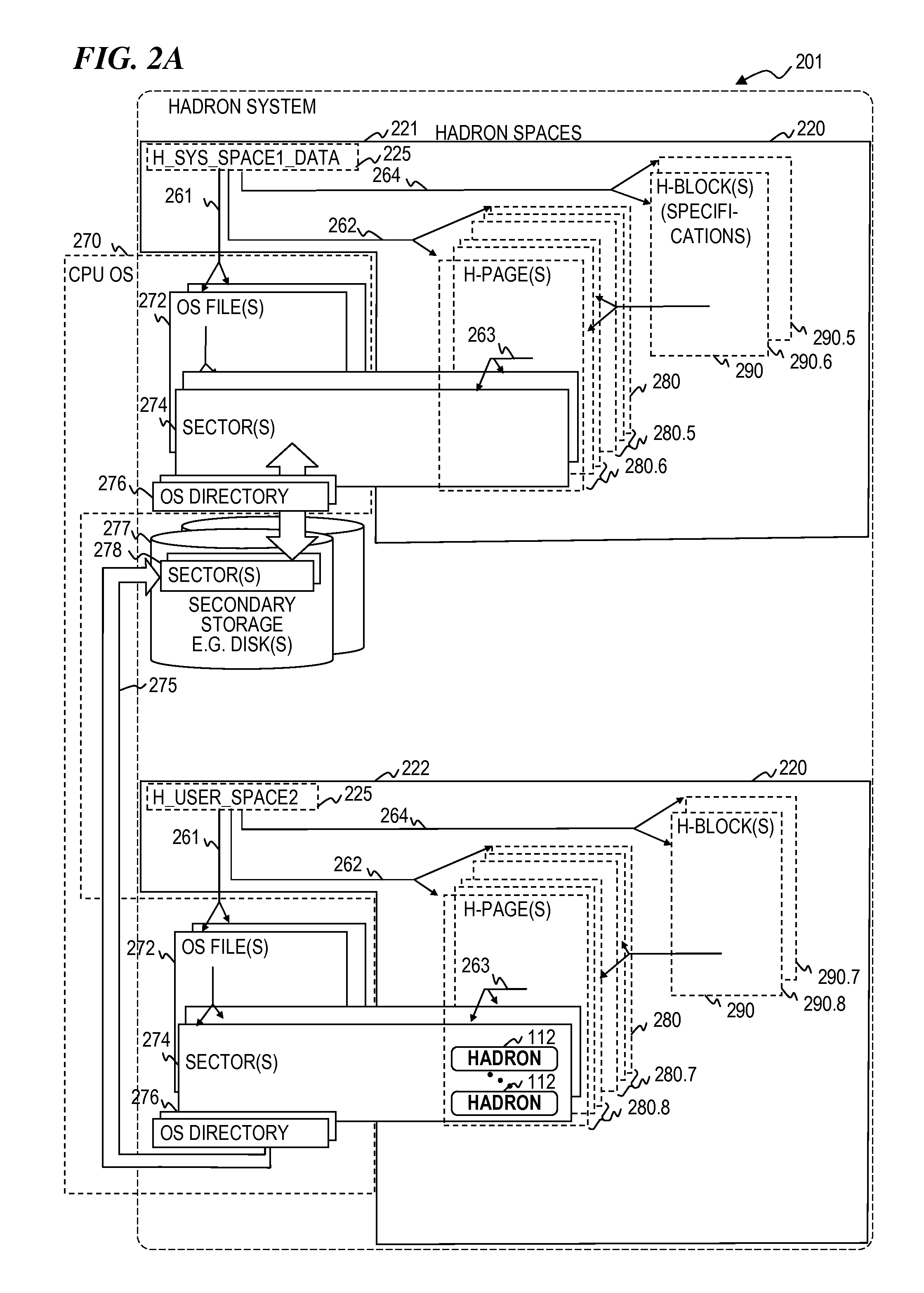Apparatus and method for organizing, storing and retrieving data using a universal variable-length data structure
a data structure and variable-length technology, applied in the field of computer storage, can solve the problems of affecting system implementation, affecting system implementation, and affecting the ability to store data, and achieve the effect of parallelism
- Summary
- Abstract
- Description
- Claims
- Application Information
AI Technical Summary
Benefits of technology
Problems solved by technology
Method used
Image
Examples
case # 1
[0176]Case #1—Empty Set
[0177]Assume the need to store one empty set { }. The empty set does not have any elements and also, in this case, does not have a name.
[0178]In some embodiments, every hadron 112 belongs to a hadron frame 101 with a specific FID 125, is associated with a specification component “S”122, and consists of two elements:
[0179]1. hadron Id component “I”121
[0180]2. holder component “H”123
[0181]Also, every hadron 112 must be unique within its universe. “Universe” here is used in the sense of “universe of discourse,” meaning a set that contains all the objects that enter into our discussion.
[0182]Every hadron 112 is to be created at a certain point of time. In some embodiments, within a universe, no two hadrons 112 may be created at (and marked at, or marked with) the same point in time.
[0183]For the case of storing one empty set { }, then:
[0184]
TABLE 2.1(1) Syntax: Core Meta Syntax (CMX) Level 410CMX_CodeExpressionData TypeAllowed Values2DatasetStringName A6Dataset Ty...
case # 2
[0188]Case #2—Non-Empty set with one member. Consider the example:
[0189]Litres_in_gallon {3.785411784}
[0190]
TABLE 3.1(1) Syntax: Core Meta Syntax (CMX) Level 410CMX_CodeExpressionData TypeAllowed Values2DatasetStringName A6Dataset TypeStringList, Tree, Table, Graph103Spec to DatasetD-Bond-HF104Spec Data TypeStringString, Number, Date,Boolean
[0191]
TABLE 3.2(2) Meta: Meta Information Level (MIL) 411FIDISH1001678100litres_in_gallon1001679101List100268010210011002681103Number
[0192]In the above example, there are two hadron frames, one frame with FID=1001 with two hadrons each having the 1001 FID indicator, and another frame with FID=1002 with two hadrons each having the 1002 FID indicator. Hadrons of the frame FID=1001 (hadrons with Identifiers I=678 and I=678, or simply referred to as hadron I=678 and hadron I=679) are S-Bonded with 100 (Dataset Name) and 101 (Dataset Type) from the CMX level. Hadrons of the frame FID=1002 (hadrons I=680 and I=681) are S-Bonded with 102 (Spec to Datase...
case # 3
[0199]Case #3—List. Consider the example:
[0200]Years_of_WWII {1939, 1940, 1941, 1942, 1943, 1944, 1945}
[0201]
TABLE 4.1(1) Syntax: Core Meta Syntax (CMX) Level 410CMX_CodeExpressionData TypeAllowed Values2DatasetStringName A6Dataset TypeStringList, Tree, Table, Graph103Spec to DatasetD-Bond-HF104Spec Data TypeStringString, Number, Date,Boolean
[0202]
TABLE 4.2(2) Meta: Meta Information Level (MIL) 411FIDISH1001678100Years_of_WWII1001679101List100268010210011002681103Number
[0203]
TABLE 4.3(3) Data: Main Information Level (MNIL) 412FIDISH100369010021939100369110021940100369210041942100369310021942100369410021943100369510021944100369610021945
PUM
 Login to View More
Login to View More Abstract
Description
Claims
Application Information
 Login to View More
Login to View More - R&D
- Intellectual Property
- Life Sciences
- Materials
- Tech Scout
- Unparalleled Data Quality
- Higher Quality Content
- 60% Fewer Hallucinations
Browse by: Latest US Patents, China's latest patents, Technical Efficacy Thesaurus, Application Domain, Technology Topic, Popular Technical Reports.
© 2025 PatSnap. All rights reserved.Legal|Privacy policy|Modern Slavery Act Transparency Statement|Sitemap|About US| Contact US: help@patsnap.com



